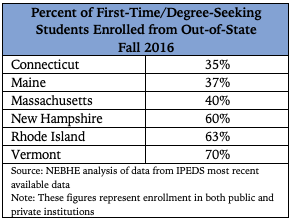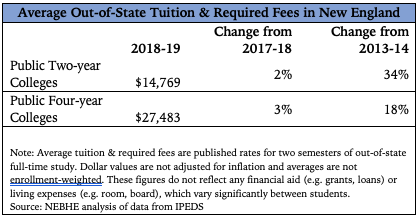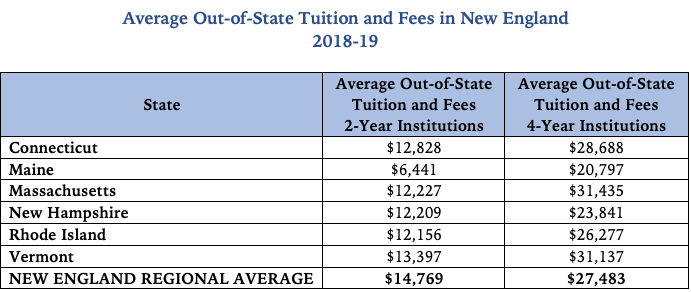As a follow up to our recent report Published Tuition and Fees at New England Public Colleges and Universities, 2018-19, this article explores out-of-state tuition and required fees in New England …
Imagine a prospective student living in Vermont. Their most affordable college option is a public university in Vermont. By staying in-state and attending the University of Vermont, this student would pay $18,276 per year in tuition and required fees. If, instead, the student attended the Community College of Vermont, they would pay $6,965 annually.
 On the other hand, an out-of-state resident from Maine who is interested in the Vermont institutions would be on the hook for $41,356 at the University of Vermont or $13,397 at the Community College of Vermont. The Maine student would pay at least double what the Vermont-resident counterpart would pay. While remaining in Maine and paying in-state tuition at the University of Maine at Augusta, for example, would be the more financially responsible choice for this Mainer, the draw of Vermont and its institutions’ program offerings or the desire to experience a new state is a common reality for many New England students. In fact, in fall 2017, approximately 80,500 first-time degree-seeking students from the U.S. attended public colleges in New England. Notably, 86% of these students were from New England states and paid in-state tuition, while 14% were from states outside the region and paid the higher out-of-state tuition.
On the other hand, an out-of-state resident from Maine who is interested in the Vermont institutions would be on the hook for $41,356 at the University of Vermont or $13,397 at the Community College of Vermont. The Maine student would pay at least double what the Vermont-resident counterpart would pay. While remaining in Maine and paying in-state tuition at the University of Maine at Augusta, for example, would be the more financially responsible choice for this Mainer, the draw of Vermont and its institutions’ program offerings or the desire to experience a new state is a common reality for many New England students. In fact, in fall 2017, approximately 80,500 first-time degree-seeking students from the U.S. attended public colleges in New England. Notably, 86% of these students were from New England states and paid in-state tuition, while 14% were from states outside the region and paid the higher out-of-state tuition.
Since 2017-18, average out-of-state tuition and fees in New England have increased by 2% ($304) at public two-year institutions and 3% ($732) at public four-year institutions. Since the 2013-14 academic year, tuition and required fees have risen 34% and 18%, respectively. These rates are higher than in-state tuition increases since 2013-14—21% at two-year colleges and 20% at four-year colleges. Massachusetts maintains the highest out-of-state tuition and fees at four-year institutions in the region ($31,802) and has experienced the steepest increase in these prices since 2013-14 (58%). Vermont has decreased out-of-state tuition and fees at its two-year public institution (Community College of Vermont) by 3% ($388) since 2017-18—the only state in the region to do so. That said, the Community College of Vermont still has the highest out-of-state tuition and fees among public two-year institutions in the region, charging students $13,397 per year.
 Maine has the lowest tuition and fees at public two-year institutions ($6,441). Maine also has the lowest out-of-state tuition and fees for public four-year institutions in the region ($20,797). It has increased out-of-state tuition and fees by only 4% at four-year institutions and 7% at two-year institutions since 2013-14. These are the smallest increases in the region. To further reduce these prices, the University of Maine System (UMS) has implemented the Flagship Match Scholarship to provide financial assistance to out-of-state students enrolled in the spring or fall 2020 classes. Flagship Match allows qualified out-of-state UMS students to pay tuition and fees equivalent to those at the flagship institution in their home state. Transfer students are also eligible for this program.
Maine has the lowest tuition and fees at public two-year institutions ($6,441). Maine also has the lowest out-of-state tuition and fees for public four-year institutions in the region ($20,797). It has increased out-of-state tuition and fees by only 4% at four-year institutions and 7% at two-year institutions since 2013-14. These are the smallest increases in the region. To further reduce these prices, the University of Maine System (UMS) has implemented the Flagship Match Scholarship to provide financial assistance to out-of-state students enrolled in the spring or fall 2020 classes. Flagship Match allows qualified out-of-state UMS students to pay tuition and fees equivalent to those at the flagship institution in their home state. Transfer students are also eligible for this program.
Rhode Island College has a program similar to Flagship Match called Northeast Neighbors. Through Northeast Neighbors, eligible residents from other New England states pay approximately 150% of in-state tuition and fees ($13,688); students outside of New England must pay the full out-of-state cost of $23,043 (this cost is still lower than the regional average).
New England students are eligible to save on out-of-state tuition through NEBHE’s Tuition Break/New England Regional Student Program for approved degree programs, including those not offered by the public colleges or universities in their home states. In some cases, students may be eligible when the out-of-state institution is closer to home or offers a larger selection of programs. Check out Tuition Break for more!
View Data in NEBHE’s Interactive Data Platform

Charlotte Peyser is a policy and research analyst at NEBHE.
[ssba]
